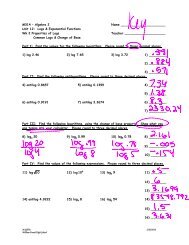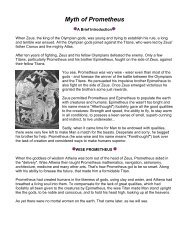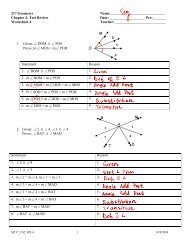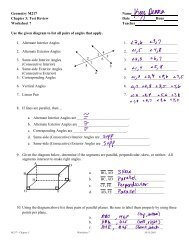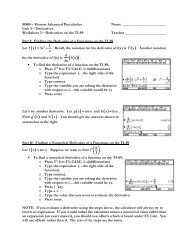Create successful ePaper yourself
Turn your PDF publications into a flip-book with our unique Google optimized e-Paper software.
The Impact of <strong>World</strong> <strong>War</strong> <strong>II</strong> on Key American Groups<br />
Directions: With a partner, choose a handout to analyze. Read the information provided about that group’s<br />
experiences during <strong>World</strong> <strong>War</strong> <strong>II</strong>. Examine the photo on the other side of the handout for other information or clues to<br />
help you better understand the impact of the war on that group. Record your observations on the matrix. Be prepared to<br />
discuss your observations<br />
Group<br />
African<br />
Americans<br />
Children<br />
Consumers<br />
GI’s<br />
Government<br />
Mexican<br />
Americans<br />
Women<br />
How did WW<strong>II</strong> impact this<br />
group in general?<br />
What is the most striking<br />
way this group was<br />
affected by WW<strong>II</strong>?<br />
Overall, do you think<br />
WW<strong>II</strong> had a positive or a<br />
negative impact on this<br />
group? Explain.
Positive and Negative Impacts of WW<strong>II</strong> on America<br />
Directions: Fill out the following chart with information from the in class discussion.<br />
National Unity<br />
Quality of Life<br />
Race Relations<br />
Economic<br />
Conditions<br />
Gender Issues<br />
Positive Impacts Negative Impacts
African Americans During <strong>World</strong> <strong>War</strong> <strong>II</strong><br />
African Americans' response to the outbreak of <strong>World</strong> <strong>War</strong> <strong>II</strong> was ambivalent. Unlike in <strong>World</strong> <strong>War</strong> I, when African-<br />
American leader W.E.B. Du Bois had urged his people to set aside their grievances and rally to the war effort, the African-<br />
American leadership supported fighting <strong>World</strong> <strong>War</strong> <strong>II</strong> on two fronts: "victory over our enemies at home and victory over our<br />
enemies on the battlefields abroad." One African-American newspaper declared, "Our war is not against Hitler in Europe<br />
but against the Hitler’s in America." After the attack on Pearl Harbor in 1941, an African-American sharecropper reportedly<br />
told his landlord, "By the way, Captain, I hear the laps done declared war on you white folks."<br />
African Americans fought this dual fight both on the home front and in the military, with some success. The increase in<br />
war production provided good jobs for African Americans. Around two million worked in aircraft factories, steel mills, and<br />
shipyards. For the first time, African-American women were able to find jobs other than as domestic servants and farm<br />
laborers. They joined the war effort by taking positions in factories.<br />
Migration of African Americans in search of work from the South to northern and western cities continued to change the<br />
nation's demographic map. While African Americans' contribution to the war industry was significant, white workers<br />
resented their competition for jobs. In addition, the influx of African Americans to the North aggravated housing shortages,<br />
causing further resentment from many whites. This resentment sometimes led to violence. In 1943 race riots broke out in<br />
Los Angeles, New York, and, worst of all, Detroit. In Detroit, 25 African Americans and 9 whites died in a riot that took<br />
place as African-American families attempted to move into a new federal housing project. One African-American woman<br />
from Detroit observed, "There ain't no North any more. Everything now is South."<br />
Discrimination also continued to plague the more than one million African Americans in the armed forces. While, unlike<br />
during <strong>World</strong> <strong>War</strong> I, most African Americans were admitted as soldiers rather than as kitchen help and waiters, those in<br />
the navy were given jobs as porters. African Americans served under segregated and discriminatory conditions. Military<br />
policy stipulated that white officers would command African-American units of soldiers. Military leaders argued:<br />
"Leadership is not imbedded in the negro race yet and to try to make commissioned officers to lead men into battle-colored<br />
men-is only to work a disaster to both." In training camps, African-American soldiers had segregated mess halls,<br />
movie houses, and recreation facilities. As General George Marshall saw it, desegregation of the army would destroy<br />
morale "established by the American people through custom and habit."<br />
Throughout the war, African-Americans soldiers were regularly humiliated on the home front. One GI, Lloyd Brown,<br />
recalled the greeting he and some others received in a lunchroom on the main street in Salina, Kansas: "As we entered,<br />
the counterman hurried to the rear to get the owner who hurried out front to tell us with urgent politeness: 'You boys know<br />
we don't serve colored here.' Of course we knew it. They didn't serve 'colored' anywhere in town…. We ignored him, and<br />
just stood there inside the door, staring at what we had come to see-the German prisoners of war who were having lunch<br />
at the counter. . .. We continued to stare. This was really happening!... The people of Salina would serve these enemy<br />
soldiers and turn away African-American GIs."<br />
Despite the continued discrimination, African Americans made significant progress in civil rights during the war. In early<br />
1941-following the threat of a march of 100,000 African Americans on Washington DC, to protest prejudice against<br />
African-American workers Roosevelt issued Executive Order 8802 banning discrimination in all government agencies, job<br />
training programs, and companies doing business with the federal government. It also established the Fair Employment<br />
Practices Commission (FEPC) to insure equal treatment for African Americans and other minorities in war industries. The<br />
immediate results for African Americans were limited. Following the war, when GIs returned to the jobs they had left,<br />
many African Americans were pushed out of the positions they had assumed during the war.<br />
Still, experiences during <strong>World</strong> <strong>War</strong> <strong>II</strong> planted the seeds for future change. Positive overseas experiences made African-<br />
American servicemen less willing to accept racial restrictions at home. While the prejudice of many Americans, including<br />
government officials and police officers, tended to override the new laws, the legislation set a new precedent for civil<br />
rights. In addition, public horror over the slaughter of six million Jews during the Holocaust forced many to reassess the<br />
United States' own racial policies.
Children During <strong>World</strong> <strong>War</strong> <strong>II</strong><br />
Shortly after the United States entered the war, President Roosevelt declared in a fireside chat that there is "one front<br />
and one battle where everyone in the United States-every man, woman, and child-is in action. That front is right here at<br />
home." Children on the home front rallied to the war effort by participating in scrap-metal drives, earning money for war<br />
bonds, and joining the labor force. They were also impacted by the war in profound ways because of unprecedented<br />
family mobility, widespread employment of women, and the prolonged absence of fathers called to service.<br />
Family mobility during the war created numerous challenges for families and children. In the three and one-half years<br />
after the United States joined the war, 12 million men left home to enter the armed services and more than 15 million<br />
civilians moved to new homes. Most of them moved to industrial centers in search of jobs, but some moved to be closer<br />
to military bases. Thus, millions of American children had to adjust to being uprooted from familiar surroundings, to the<br />
prolonged absence of their fathers, and to reduced attention from their parents. One of the most difficult adjustments for<br />
families was the loss of a father to the armed services and the constant anxiety about his safety and well-being.<br />
In addition, as upward of 16 million women worked full time outside the home during the war, more and more children<br />
were separated from both parents for long periods. Due to the near-absence of supportive community services such as<br />
childcare centers and communal kitchens, children sometimes suffered from diminished attention or even neglect. And,<br />
since many schools were overcrowded, some children could only attend school for half the day. The children left to fend<br />
for themselves while their mothers worked were called "latchkey children" or "eight-hour orphans" and were a cause for<br />
great concern. In 1940 Congress passed the Lanham Act to give federal aid to communities that had to accommodate<br />
large war-related populations. The act provided funds for daycare centers, hospitals, sewer systems, police and firefighting<br />
facilities, and recreation centers. But care was provided for only 107,000 children. Many children who did not<br />
receive care wandered the streets or were locked in cars or sent to all-day, and sometimes even all-night, movies. In<br />
one area devoted to war industry in Los Angeles, one social worker discovered 45 infants locked in cars in a parking lot.<br />
The war also changed the lives of many adolescents. Between 1940 and 1944, the number of teenagers attending<br />
school declined by 12.5 million, and most who left school took jobs. As a result, the previous trend toward reduced child<br />
labor was temporarily reversed. The number of teenage workers spiraled from one to over three million-one-third of their<br />
age group-which meant that four times as many 14- and 15-year-old girls were working at the end of the war than at the<br />
start. Not only were more young people working, but they were performing heavier work in industries such as<br />
manufacturing.<br />
The wartime increase in child labor meant the loss of education for children, as well as an increase in illegal<br />
employment. In New York, for example, the number of boys and girls illegally employed jumped by nearly 400 percent. A<br />
survey of pinsetters in bowling alleys showed that "boys as young as nine years go to the alleys after school, eat supper<br />
in an upstairs or back room, and work until midnight on school nights and until 3 or 4 o'clock in the morning on Sunday."<br />
Working for long hours, and late at night, left children fatigued during school and contributed to the increasing number of<br />
students who did not finish school.<br />
One indicator of the difficult adjustments children had to make during the war was the surge in juvenile crime. Juvenile<br />
arrests climbed 20 percent nationwide in 1943. In San Diego, arrests increased 55 percent for boys and 355 percent for<br />
girls. Promiscuity rose among young women, and many girls became prostitutes. Arrests for the crime soared 68<br />
percent. Among boys, theft was the most common crime, but vandalism and violence were also problems.<br />
Perhaps due to statistics on crime and dropout rates, the massive positive contributions children made to the war effort<br />
were often overlooked or minimized. Taking part in home front activities provided children with a real sense of<br />
involvement in the war. Children gave their own nickels and dimes to buy war stamps and bonds, ultimately contributing<br />
over 100 million dollars to the war effort. They also took a particularly active role in community drives to collect scrap<br />
metal, paper, and rubber, all of which were needed to meet the rapid growth of U.S. industrial production. Heeding the<br />
words of a Bing Crosby song that said, "Junk ain't junk no more/Cause junk can win the war," children launched tireless<br />
efforts to collect scrap metal to be converted into bombs and shells. Giving themselves such names as the "Tin-Can<br />
Colonels" and "Uncle Sam's Commandos," groups of children rummaged through attics, emptied garages, and pulled<br />
their wagons through the streets looking for discarded pots, pans, tin cans, bedsprings, and other scrap metal. They<br />
even made door-to-door collections of aluminum.<br />
Children also collected waste paper, which was made into the cartridge belts used to carry ammunition. In Chicago<br />
schools, for example, every Wednesday was "Paper Day" and students brought bundles of newspapers to school where<br />
the teacher measured them. The student who brought the thickest pile of papers was awarded a gold pin for the week.<br />
In just five months, Chicago schoolchildren collected 18,000 tons of newspapers. The Boy Scouts were another group<br />
that was particularly responsive to the call for rubber and scrap metal, collecting a total of 109 million pounds of rubber<br />
and 370 million pounds of scrap metal.
Consumers During <strong>World</strong> <strong>War</strong> <strong>II</strong><br />
After the long years of the Great Depression, during <strong>World</strong> <strong>War</strong> <strong>II</strong> in the 1940s Americans found themselves enjoying a quality<br />
of life that many of them could barely remember. The production of war materials stimulated the economy and created<br />
thousands of jobs. Since the war was not fought on U.S. soil, the Allies became dependent on the United States for food,<br />
supplies, and military goods. As a result, business and farm profits more than doubled between 1939 and 1943, and wages and<br />
salaries rose by 135 percent between 1940 and 1945. At every level of society men, women, and even children had money to<br />
spend. In spite of rationing, shortages, and price controls, most Americans were excited about their increased income.<br />
However, they were also frustrated by wartime shortages that denied them many of the goods they wanted. Savings accounts<br />
ballooned.<br />
Immediately after the bombing of Pearl Harbor in 1941, a race for consumer goods began. Americans began to stock up on<br />
goods at a record rate, propelled by rising incomes and prices and rumors of shortages, rationing, and controls. Studies showed<br />
that Americans were hoarding many things. These included food, rubber goods, household supplies, and other miscellaneous<br />
items, such as rifles and shotgun shells and typewriters.<br />
The Roosevelt administration recognized that in this atmosphere, inflation could become a major problem. To combat inflation,<br />
he considered instituting controls on prices of goods. However, government price fixing was unprecedented in U.S. history.<br />
Many felt that it conflicted with the American tradition of a free market, and there were heated debates in Congress over the<br />
issue. After several months of debate, Congress passed the Price Control Act in January 1942. As a result, the Office of Price<br />
Administration (OPA) was established to set controls on consumer goods that were in short supply. The OPA set controls on a<br />
wide variety of consumer goods, fixed rents, and created a system of rationing for products such as sugar, coffee, meat, and<br />
butter. By the time the controls were authorized, prices had already risen about 25 percent. While prices continued to rise<br />
slightly on the goods with price ceilings, the act did curtail serious inflation.<br />
Under the rationing system, consumers were given a specific number of coupon books and stamps that stipulated their ration of<br />
goods. Used to having access to as many goods as they could afford, many Americans were frustrated by the limits placed on<br />
their spending. Rationed goods included tires, fuel oil, and gasoline, which was limited to three gallons per person per week.<br />
Since it limited people's mobility, gasoline rations were especially unpopular. In addition, almost every staple in the American<br />
diet was strictly rationed by a point system. Meat, coffee, butter, cheese, and sugar were rationed by assigning a point value to<br />
each good. To purchase food, consumers paid their grocer a combination of money and stamps, each of which was worth a<br />
certain number of points.<br />
The rationing system created a huge accounting problem. Grocers had to deal with billions of tiny stamps each month. They<br />
paid the stamps to wholesalers to get more food, and the wholesalers in turn gave the stamps to banks to get credit to buy more<br />
food. The system also gave rise to "black market" activity that catered to dissatisfied consumers willing to pay well above the<br />
prices set by the OPA on rationed items. For example, boneless ham sold on the black market for $1.25 a pound, almost twice<br />
its legal price ceiling. Women's nylon stockings could be purchased on the black market for $5 a pair.<br />
During the war, many Americans struggled to overcome the inconveniences they faced due to shortages and rationing. To aid<br />
them, Gourmet, a food journal, was created just as the war began. Wine connoisseurs were advised to turn their attention from<br />
European wines to California wines. The spice trade was stopped as a result of the war, so the journal featured instructions on<br />
how to cultivate an herb garden and adapt favorite recipes. Smoked salmon was declared one of the few gourmet appetizers<br />
left since the end of the caviar trade. Gourmet encouraged the use of wild game, such as venison and rabbit, to release<br />
domesticated meats for other uses. At Easter time, the magazine quoted the following verse: "Although it isn't / Our usual habit,<br />
/ This year we're eating / The Easter Rabbit."<br />
Besides diet and mobility, rationing also affected American clothing. The <strong>War</strong> Production Board, worried about wool supplies,<br />
issued an order forbidding the inclusion in men's suits of an extra pair of trousers, a vest, patch pockets, or cuffs. It called for the<br />
manufacture of only single-breasted and somewhat shorter jackets with narrower lapels. Women's fashions were similarly<br />
affected by the war. As cotton, wool, and nylon supplies dropped, the government ordered that skirts be designed without<br />
pleats, and dresses be fastened without the use of zippers, to save precious materials. In addition, cloth in women's bathing<br />
suits was reduced by 10 percent, changing the fashion from the billowing bathing skirts of the 1930s and concentrating on twopiece<br />
rather than one-piece outfits.<br />
In the spirit of economizing for the war effort, consumers began to recycle waste products. Households eagerly collected tin<br />
cans and any objects containing bronze or steel to recycle for war materials. Silk stockings were turned into powder bags for<br />
naval guns. Paper was collected to make packing cartons. Old tires were collected to make gas masks and other war materials.<br />
Bacon grease was collected at the butcher shop to use in making ammunition.<br />
Americans planted gardens in any open space available to grow produce for themselves. The government wanted to ship as<br />
many farm products as possible to the Allies overseas. As a result, Americans at home were urged to plant "victory gardens."<br />
This was yet another way Americans could show support for the war effort.
GIs During <strong>World</strong> <strong>War</strong> <strong>II</strong><br />
When the United States declared war on Japan and entered <strong>World</strong> <strong>War</strong> <strong>II</strong>, the government moved swiftly to build up a<br />
fighting force. Millions left their homes to be trained as soldiers in military installations. Six million men and women<br />
volunteered for service. Another 10 million were drafted. For the first time in U.S. history, women were permitted to<br />
volunteer for non-combat duty. By the war's end, more than 200,000 women had served in the armed forces.<br />
American soldiers were the best-equipped soldiers in the world. Each was furnished with clothing for all occasions and<br />
climates, as well as equipment to survive life on the front. Because they wore "government issue" or "GI" outfits, <strong>World</strong><br />
<strong>War</strong> <strong>II</strong> servicemen were nicknamed "GIs." Despite the equipment, the transition from civilian life to military life was quick<br />
and shocking. Soldiers were required to prepare for combat duty, which included land, air, or sea duty. Many soldiers<br />
sought alternatives to combat, including officer-training school and special vocations such as foreign-language translation<br />
and health care.<br />
Life in the service was a mixture of high stress and boredom. While in training, or in between attacks, the men lived at<br />
various military posts, some of which were converted school buildings, quickly constructed shelters, or ships. There they<br />
were responsible for the daily chores of housekeeping-mopping, washing laundry, mending uniforms, dishwashing, and<br />
hauling garbage. There was little privacy, as many men lived together in small rooms.<br />
Homesickness among soldiers was prevalent. Consequently, mail was an important part of military life. Because of the<br />
amount of mail to be transported overseas, a new small, lightweight letter form called V-mail was designed. V-mail<br />
reduced the precious space that letters took up on supply ships crossing the Atlantic. Soldiers carried the letters they<br />
received with them for weeks, and often even memorized them. However, even mail was not immune from the<br />
surveillance of soldiers' superiors. All mail was censored by the army so as not to release any secrets of troop movement<br />
or operation.<br />
GIs were affected by warfare in different ways. Combat training and experience on the battlefront hardened some<br />
soldiers, making them effective in battle. One pilot was quoted as saying, "It would be nice...to get home...and stretch my<br />
legs under a table full of Mother's cooking….But all I want to do is beat these Nazis.. .so we can get at those little Japs. .<br />
.." For others, combat was more of a question of survival. As one GI said, "You shoot him in the back, you blow him apart<br />
with mines, you kill or maim him...with the least danger to yourself. He does the same to you.. .and if you don't beat him<br />
at his own game you don't live." Still others became repulsed by the killing and sought to turn away from the war.<br />
One soldier stated, "No normal man who has smelled and associated with death ever wants to see any more of it….The<br />
surest way to become a pacifist is to join the infantry."<br />
The GIs overseas, many of whom had never traveled outside the United States, shared one obsession: returning home.<br />
Faced with homesickness and the monotony of life in the military bases, they longed to return to a place where daily life,<br />
including the food, was familiar. One war correspondent wrote, "Our men.are impatient with the strange peoples and<br />
customs of the countries they now inhabit. They say that if they ever get home they never want to see another foreign<br />
country." According to the New York Times, some soldiers longed for the place "where the thermometer goes below 110<br />
at night...where there are chocolate milkshakes, cokes, iced beer, and girls." One GI complained about British food,<br />
stating, "What wouldn't I give right now for a piece of bread spread with soft butter, heaped with American peanut butter,<br />
and accompanied by a big glass of ice-cold milk!"
The Government During <strong>World</strong> <strong>War</strong> <strong>II</strong><br />
During <strong>World</strong> <strong>War</strong> <strong>II</strong>, the government a played a heavy role in monitoring U.S. production, the economy, and<br />
communication. To support the soldiers fighting on the front lines, the government urged American farmers and workers<br />
to produce the food and equipment needed by U.S. and Allied troops. Roosevelt's administration controlled labor strikes,<br />
created a rationing system to control inflation, raised taxes to pay for the war, and censored communication to protect<br />
against leakage of strategic information.<br />
In 1942 President Roosevelt announced previously unheard-of production goals: 60,000 airplanes, 45,000 tanks, 20,000<br />
antiaircraft guns, and 8 million tons of merchant shipping. To meet these goals, Roosevelt created the <strong>War</strong> Production<br />
Board, which was responsible for converting factories and plants from consumer-oriented production to military<br />
production. Factories that had manufactured shirts redesigned assembly lines to make mosquito netting. Model-train<br />
producers made bomb fuses. Metal weather stripping factories switched to producing mortar shells. Kitchen-sink<br />
assembly lines were retooled to produce cartridge cases. All manufacture of automobiles switched to full-time production<br />
of tanks, trucks, armored personnel carriers, and aircraft. Because vital manufacturing materials, such as rubber, tin, and<br />
quinine, were in dangerously short supply, the government carefully rationed existing supplies.<br />
To meet the aggressive wartime production goals, the government felt the country could not afford delays in production<br />
that might be caused by labor disputes. To prevent potential problems, the government established the National <strong>War</strong><br />
Labor Board to settle labor disputes through mediation and arbitration. The board restricted wage increases to equal<br />
increases in the cost of living. Congress also passed the Smith-Connally <strong>War</strong> Labor Disputes Act, which required unions<br />
to give 30 days' notice before a strike vote, authorized the president to seize an essential industry where production was<br />
interrupted by work stoppages, and made it a federal crime to initiate or assist strikes in government-operated plants. In<br />
December 1943 Roosevelt had the army take possession of the nation's railroads to prevent a threatened strike by<br />
railway workers. It was returned to private management within a month.<br />
To pay for the war, the government had to raise huge amounts of money. It did so by raising taxes and by borrowing.<br />
Taxes reached as high as 94 percent for the highest incomes and still only amounted to 41 percent of the war cost. To<br />
supplement this income, the government borrowed from individuals through war bonds, from banks, and from<br />
corporations. Regular deductions, with the consent of the workers, were taken out of paychecks for bond purchases. The<br />
government mounted drives to sell bonds and boosted patriotic spirit using movie stars, and comic book heroes, such as<br />
Batman and Dick Tracy.<br />
Such methods of collecting money also served to safeguard against inflation. With employment high, most Americans<br />
had money to spend. Because few goods were available to buy during the war, prices rose rapidly. The government<br />
determined that if people loaned their money to the government for war bonds, they would have less to spend on goods<br />
and prices could be kept down.<br />
Roosevelt also established the Office of Price Administration (OPA) to help control inflation. The OPA set price ceilings<br />
on most items, and instituted rent control, since housing was scarce throughout the war. The agency created a system of<br />
rationing for such products as gasoline, tires, coffee, canned food, and meat. Under the rationing system, consumers<br />
were given a specific number of coupon books and stamps that stipulated their ration of goods. These measures<br />
succeeded in avoiding serious inflation during the war.<br />
To protect national security and strategic military information, Roosevelt issued an executive order that set up the Office<br />
of Censorship. This office censored all communications between the United States and other nations. Letters written by<br />
soldiers to their friends and families were censored to prevent leakage of important military information that could get into<br />
the hands of the enemy. The news media agreed to voluntary censorship, promising not to publish or broadcast<br />
information relating to military security without first clearing it with the federal government.<br />
The government also created the Office of <strong>War</strong> Information to keep the public informed on the progress of the war and<br />
the policies and aims of the government. It was hoped that this would make most news readily available; however, rigid<br />
government censorship stopped the spread of much detailed information. For example, it kept quiet a military blunder in<br />
the invasion of Sicily, Italy that resulted in an Allied bombing of U.S. paratroopers.
Mexican Americans During <strong>World</strong> <strong>War</strong> <strong>II</strong><br />
Tensions on the home front during <strong>World</strong> <strong>War</strong> n increased the discrimination faced by Mexican Americans and<br />
Mexicans working in the United States. With the conversion of the economy to war production, and departure from jobs<br />
of many Americans to join the armed forces, the need for labor rose rapidly. To help meet this need the United States<br />
and Mexico created the bracero program in 1942. Under this program, Mexicans were permitted to come and work in<br />
the United States under short-term contracts. In the same year, 17,000 people of Mexican descent took jobs in Los<br />
Angeles shipyards to support the war effort.<br />
The Mexican-American population was centered in the Southwest, with a large group in Los Angeles. Most Mexican<br />
Americans were born and grew up in neighborhoods that were almost entirely Mexican, and many of them had not<br />
mastered written or spoken English. Like many recent immigrants, they were crowded into run-down urban areas,<br />
exploited as farm workers, suffered high unemployment rates, and met hostility from longtime residents. In Los<br />
Angeles, many places of entertainment refused to admit Mexican Americans. For example, at one skating rink, a sign<br />
was posted that said, "Wednesdays reserved for Negroes and Mexicans." The press in California often associated<br />
Mexican Americans with sex crimes, stabbings, gang violence, marijuana, and a racial inferiority that supposedly<br />
accounted for their poverty.<br />
During the early 1940s some Mexican Americans adopted a flamboyant style of dress, called a "zoot suit," which had<br />
originated in Harlem and spread to the West Coast. The zoot suit consisted of a long jacket and trousers tightly pegged<br />
at the cuff, fully draped around the knees, and deeply pleated at the waist. The boys and men who dressed in this<br />
fashion became known as "zooters." Most zooters also wore their hair long, full, greased, and gathered in a ducktail.<br />
Many of them belonged to youth gangs, some of which had wholly social purposes, and others of which were organized<br />
for delinquent activities.<br />
Many white people lumped all Mexican Americans into the category of zooter gang members, and white servicemen<br />
from across the country who were stationed in and around Los Angeles shared the prejudice. In July 1943 sailors and<br />
soldiers stormed Mexican-American neighborhoods to beat up zooters, demanding revenge for alleged attacks against<br />
GIs. One report stated: "Procedure was standard: grab a zooter. Take off his pants and frock coat and tear them up or<br />
bum them. Trim the... 'ducktail' haircut that goes with the screwy costume." In the streets, boys as young as 12 and 13<br />
were being beaten and stripped of their clothes. The Shore Patrol, Military Police, and city police either looked the other<br />
way while the violence was taking place, or followed the mobs and jailed not the attackers but the victims. The violence<br />
escalated into the "Zoot-Suit Race Riots," which lasted for a week. The press attributed the violence to zooter<br />
hoodlums, and the city of Los Angeles passed an ordinance making it a crime to wear a zoot suit within city limits.<br />
The riots raised important questions about the rights of citizens against the military. In a letter to President Roosevelt,<br />
one man defended the zooters, explaining that "zoot-suiters dressed as they did to compensate for a sense of being<br />
rejected by society. The wearers are almost invariably the victims of poverty, proscription, and segregation." He added:<br />
"It is essential to discipline the offending soldiers and sailors, for otherwise these members of the armed services will<br />
believe the wearing of the uniform gives them the license to act as arbiters of how civilians may dress, speak, act or<br />
think."<br />
A citizens' committee investigated the riots and found the soldiers to blame for starting the aggressive actions. The<br />
committee declared that the GIs' actions were motivated by racial prejudice, and called for punishment of those men<br />
guilty of violent crimes. They also noted the need for public programs to improve conditions in Mexican-American<br />
neighborhoods and to combat the racial prejudice that led to events such as those in Los Angeles.
Women During <strong>World</strong> <strong>War</strong> <strong>II</strong><br />
During <strong>World</strong> <strong>War</strong> <strong>II</strong>, U.S. industry converted from consumer production to military production. Unemployment, which had<br />
been high during the Great Depression, dropped from 9.9 percent on the eve of Pearl Harbor to 1.2 percent by the end of<br />
the war. Aircraft production increased from a prewar rate of 2,100 planes a year to nearly 100,000 planes in 1944. More<br />
than 70,000 ships were constructed during the war years. This increased production created a huge demand for labor,<br />
exacerbated by the many American men who left jobs to join the U.S. military forces.<br />
In response to the need for labor, many American women entered the workforce for the first time. Posters of "Rosie the<br />
Riveter," who symbolized women who worked on factory assembly lines, and popular songs persuaded women to fulfill<br />
their patriotic duty and join the war effort. The following slogans were created to reassure women that they could do<br />
factory work as easily as household work: "If you've sewed on buttons, or made buttonholes on a machine, you can learn<br />
to do spot welding on airplane parts" and "If you've used an electric mixer in your kitchen, you can learn to run a drill<br />
press. If you've followed recipes exactly in making cakes, you can learn to load shell." Urged by the government, tens of<br />
thousands of women who had never worked outside the home took jobs from clerical positions to riveters and welders in<br />
factories.<br />
By 1944, 3.5 million women worked with the 6 million men on assembly lines. During the course of the war, over 6 million<br />
women entered the labor force. Women who had already been working, usually in service and menial jobs, eagerly<br />
applied for the better-paying positions in war industries. <strong>War</strong> work increased women's independence, income, and pride.<br />
One woman involved in the war effort said, "We were happy to be doing it. We felt terrific. Lunch hour would find us<br />
spread out on the sidewalk. Women welders with our outfits on, and usually a quart of milk in one hand and a salami<br />
sandwich in another. It was an experience that none of us had ever had before. Workers from other ships would look at us<br />
and see that we were welders and it was a terrifically wonderful thing." The opportunities the war offered women started a<br />
societal trend of women working outside the home that extended into the rest of the century.<br />
Women also served in the military during the war. For the first time in U.S. history women were permitted to volunteer for<br />
non-combat duty. Except for combat, they were enlisted to perform all types of jobs. For instance, women flew as civilians<br />
in the Women's Air Force Service, transporting military planes to Great Britain and other war fronts. By the war's end,<br />
more than 200,000 women had served in the armed forces.<br />
Although women made important strides in gaining new skills, income, and freedom, men continued to dominate<br />
supervisory positions. Most jobs were defined as either "men's work" or "women's work," and wage scales, despite<br />
government promises to the contrary, discriminated against women.<br />
In addition, even with women's important contributions to the war effort, most women were forced out of the workforce at<br />
the end of the war. While millions of women wanted to keep their jobs, most were pushed aside to make room for<br />
returning GIs. A wartime survey showed that over 75 percent of women working in two of the largest cities in the country -<br />
New York and Detroit-wanted to keep their jobs after the war. However, as one woman said, "After the war it was<br />
completely different. I went around and applied to different factories, but there were no jobs for me. So I had to fall back<br />
on the only other work I knew, and that was doing domestic work. And it was a very defeating feeling, very."<br />
Women's contributions to the military were similarly ignored. It was not until 1979 that those who served in <strong>World</strong> <strong>War</strong> <strong>II</strong><br />
were recognized as war veterans who were entitled to benefits.



